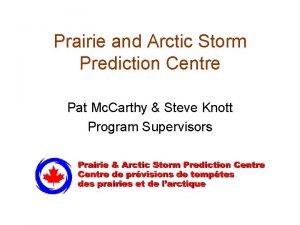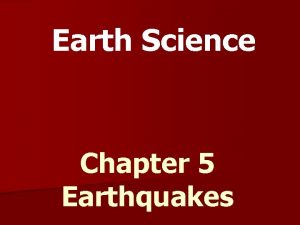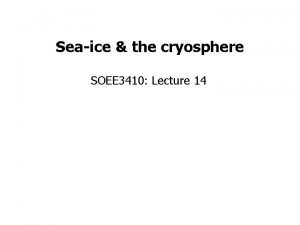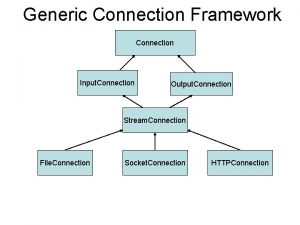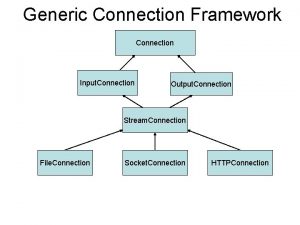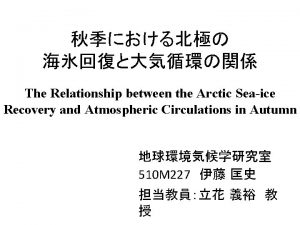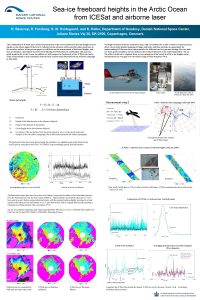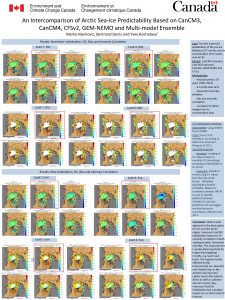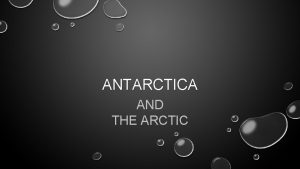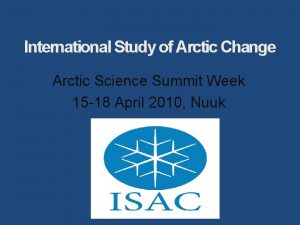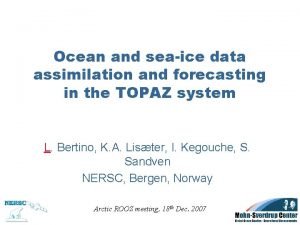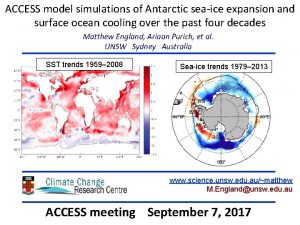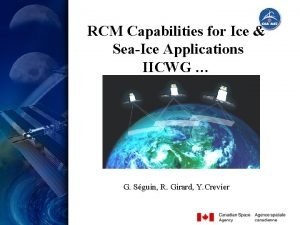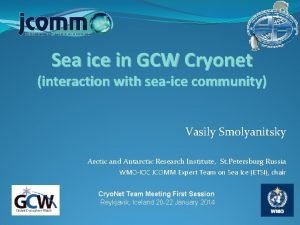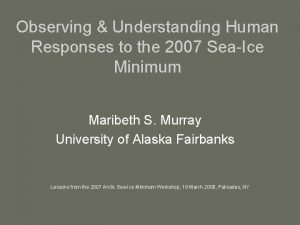Arctic SeaIce Change and Its Connection with Arctic




















- Slides: 20

Arctic Sea-Ice Change and Its Connection with Arctic Climate Change in CMIP 2 Simulations Zeng-Zhen Hu (1) Svetlana I. Kuzmina (2) Lennart Bengtsson (3) David M. Holland (4) (1) Center for Ocean-Land-Atmosphere Studies 4041 Powder Mill Road, Suite 302, Calverton, MD 20705 E-amil: hu@cola. iges. org (2) Nansen International Environmental and Remote Sensing Center Bolshaya Monetnaya Street, 26/28, St. Petersburg, 197101, Russia (3) Max-Planck-Institute for Meteorology Bundesstrasse 55, Hamburg, D-20146, Germany; and Environmental Systems Science Centre, Reading, UK (4) Center for Atmosphere-Ocean Science Courant Institute of Mathematical Sciences, New York University 251 Mercer Street, New York, NY 10012 USA

More and More People Believes that Global Warming Is True From: http: //www. giss. nasa. gov/research/observe/surftemp/2001 fig 1. gif

Possible Global Warming Signal in Observed Sea-Ice Change (Decreasing is dominated)

However, Uncertainty in CGCM Simulating the Current Climate Is Still Large, Particularly in High Latitudes. IPCC 2001, Figure 8. 2: December-January-February climatological surface air temperature in K simulated by the CMIP 1 model control runs.

How Can People Believe the Simulated Future Climate Change ? ! IPCC 2001, Figure 9. 6: (a) The time evolution of the globally averaged temperature change relative to the years (1961 to 1990) of the SRES simulations A 2 (top) and B 2 (bottom) (Unit: °C). See Table 9. 1 for more information on the individual models used here. (b) The time evolution of the globally averaged precipitation change relative to the years (1961 to 1990) of the SRES simulations A 2 (top) and B 2 (bottom) (Unit: %).

What Cause the Uncertainty ? • It is the model differences, including: (1) Model dynamic frame (2) Model physical processes cloud – radiation atmosphere chemistry land surface-hydrology sea – ice so on Among these processes, sea-ice is one of very important sources resulting in the uncertainty!

Objectives 1. The two-dimensional distribution of the mean and uncertainty of Arctic sea ice, and climate changes at the time of CO 2 doubling and their interconnection 2. The sensitivity of Arctic surface air temperature (SAT) change to sea-ice area change in different models and in various periods of forced integrations of the CMIP models 3. The possible influence of CO 2 doubling on the north-south SLP gradient and the mean westerly winds 4. The differences resulting from model -dependent physics

Observational & CMIP 2 Data 1. Observations 1 x 1 sea-ice concentration in the Arctic, 1953 -1995 (Chapman and Walsh, 1991); seasonal 1 x 1 sea-ice thickness in 1960 -1982 (Bourker and Garrett, 1987) 2. Models 14 CMIP 2 CGCMs (http: //wwwpcmdi. llnl. gov/cmip): (see next page) 3. Experiments CMIP 2 (http: //wwwpcmdi. llnl. gov/cmip): Control run: 1 -80 years Scenario run: Standard gradual increase (1 % per year compound) in CO 2, 1 -80 years; CO 2 doubling at 60 -80 years.

CMIP 2 Models Model Output Flux Adjustment Sea-ice Component BMRC SIT heat, freshwater thermodynamics CCCma SIT heat, freshwater thermodynamics CCSR SIT heat, freshwater thermodynamics CERFACS SIT, SIC none Thermodynamics, statistical subgrid-scale SIT distribution CSIRO SIT, SIC heat, freshwater, momentum thermodynamics with a cavitating fluid rheology ECHAM 3 SIT heat, freshwater, momentum thermodynamics GFDL SIT heat, freshwater thermodynamics with free-drift approximation GISS SIT, SIC none thermodynamics LMD SIT none diagnostic MRI SIT, SIC heat, freshwater thermodynamics with free-drift approximation NCAR SIT, SIC none thermodynamics with a cavitating fluid rheology NRL SIT, SIC Annual mean heat, freshwater diagnostic Had. CM 3 SIT, SIC none Thermodynamics with free-drift approximation Had. CM 2 SIT, SIC heat, freshwater thermodynamics with free-drift approximation

Surface Temperature (SAT) & Sea-Ice Thickness (SIT) Are Cooperated: Larger (smaller) warming/uncertainty of SAT is tied up with larger (smaller) reduction/uncertainty of SIT

Surface Temperature (SAT) & Sea-Ice Concentration (SIC) Are Also Cooperated: Larger (smaller) warming/uncertainty of SAT is associated with larger (smaller) reduction/uncertainty of SIC

NH Sea-Ice Area & Arctic SAT: (1) Sensitivity (-2. 0 to 0. 5 C/M km**2) is varied from model to model (2) Sensitivity is different even in different period of a transient integration; (3) Colder (warmer) Arctic climate may favor higher (lower) sensitivity; (4) Sensitivity seems not related to initial sea-ice area.

Sensitivity & the changes in poleward ocean heat transport (Holland Bitz, 2003, Clim. Dyn. ): MRI model: lowest sensitivity corresponds to strongest poleward ocean heat transport NCAR model: largest sensitivity corresponds to weakest poleward ocean heat transport

Projected SLP & Sea-Ice Thickness Changes: (1) Larger (smaller) decrease /uncertainty of SLP is associated with larger (smaller) reduction/uncertainty of SIT; (2) The north-south SLP gradient and the mean westerly winds are enhanced.

Differences resulting from model physics: Both the mean and intermodel spread patterns show considerable differences in some regions between models with and without flux adjustment.

Main Results • At the time of CO 2 doubling, Arctic SAT increases 1 to 5 C, SIT decreases 0. 3 -1. 8 m, SIC reduces more than 10%. • Values of the sensitivity of Arctic surface air temperature change with respect to sea-ice area change vary from -2. 0 to -0. 5 C/10^6 km^2 for most CMIP 2 models. The sensitivity is model dependent. For some models, the sensitivity is different even in different period of a transient integration. • Colder (warmer) Arctic climate may favor higher (lower) sensitivity. That may be associated with the intensity of poleward ocean heat transport. • The north-south SLP gradient and the mean westerly winds are enhanced at the time of CO 2 doubling. • There are considerable differences between models with and without flux adjustment in some regions. • There are NO significant and consistent sensitivity differences between the mean simulations with and without sea-ice dynamics. • Both SIT & SIC are sensitive to the increase in greenhouse gas concentrations and connected with SAT & SLP changes in the Arctic. • Simulated mean and intermodel spread patterns of SAT change are similar to those of SIT, SIC, and SLP changes, implying that the mean and uncertainty of projected Arctic climate change may be largely affected by the interaction between sea-ice and the atmosphere.

Further Information and Acknowledgements Further Information : Web page: ftp: //grads. iges. org/pub/hu/paper/2004 HUetal_JGR. pdf (JGR-Atmosphere, 109, D 10106, 2004) E-mail: hu@cola. iges. org; Acknowledgements : The authors thank E. Schneider, R. Stouffer, B. Huang, and D. Straus for their discussion and suggestions, and also B. Wu and J. Adams for their assistance in processing the observed sea-ice data. This work was supported by grant from the U. S. Department of Energy (De-FG 02 -01 ER 63256). DMH acknowledges support from the Office of Polar Programs of the National Science Foundation grants OPP-9901039 and OPP-0084286. All CMIP 2 modeling groups are acknowledged for making the simulations available. CMIP 2 is supported and the model data are distributed by the Program for Climate Model Diagnosis and Intercomparison (PCMDI) at the Lawrence Livermore National Laboratory (LLNL).

END • THANKS

CMIP 2 models simulate the mean sea-ice concentrations reasonably well

CMIP 2 models simulate the mean seaice thickness NOT very well
 Connection in literature
Connection in literature Slip critical connection vs bearing connection
Slip critical connection vs bearing connection A490n bolts
A490n bolts Minimum fillet weld size
Minimum fillet weld size The emigree poem structure
The emigree poem structure Its halloween its halloween the moon is full and bright
Its halloween its halloween the moon is full and bright What are chemical changes
What are chemical changes Absolute change and relative change formula
Absolute change and relative change formula Differences between physical and chemical changes
Differences between physical and chemical changes Change in supply and change in quantity supplied
Change in supply and change in quantity supplied What is a physical change
What is a physical change Rocks change due to temperature and pressure change
Rocks change due to temperature and pressure change Whats chemical change
Whats chemical change First-order and second-order change examples
First-order and second-order change examples Prairie and arctic storm prediction centre
Prairie and arctic storm prediction centre Anwr drilling pros and cons
Anwr drilling pros and cons When a train increases its velocity, its momentum
When a train increases its velocity, its momentum Its cloudy its sunny
Its cloudy its sunny If its a square it's a sonnet summary
If its a square it's a sonnet summary Its not easy but its worth it
Its not easy but its worth it P wave
P wave














